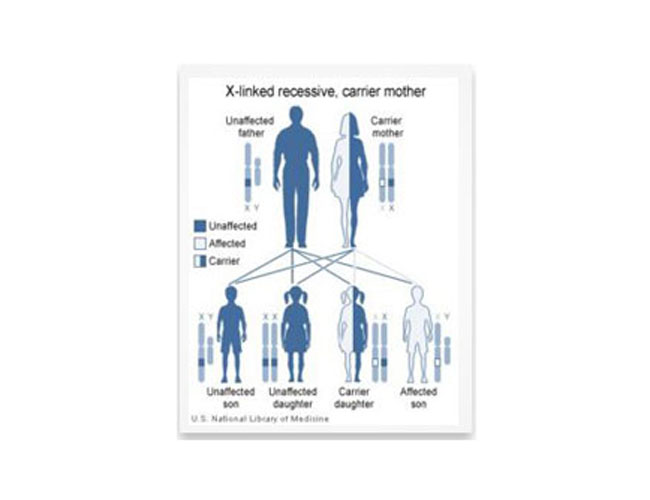X-linked recessive inheritance
Genes are the instructions or recipes made of DNA that tell our bodies how to build and repair themselves. Our genes are packaged into chromosomes with each chromosome containing hundreds of genes. We inherit our chromosomes and therefore our genes from our parents.
Genes can have tiny differences in their genetic code which make us all different and unique. Sometimes a change in the genetic code of a gene can prevent the gene from working properly and cause a genetic condition.
X-linked recessive genetic conditions usually only affect boys. This is because they are caused by a genetic change or misprint in one of the genes on the X chromosome. Boys only have one X chromosome (XY), whereas girls have two X chromosomes (XX) and therefore two copies of the genes on the X chromosome. So if there is a change in one copy of an X-linked gene, the other working copy on the other X chromosome is usually enough to compensate for this. In this situation a woman is described as a ‘carrier‘ of an X-linked condition. A boy with a genetic change in his single copy of an X-linked gene will develop the condition as he has no working copy of the gene.
Boys inherit their single X chromosome from their mother. A woman who is a carrier of an X-linked recessive condition has a 1 in 2 or 50% chance of passing the condition on to each son she has. Each of her daughters will have a 1 in 2 or 50% chance of inheriting the changed copy of the gene and being carriers of the condition.

X-linked inheritance. Photo: US Nat. Library of Medicine
The diagram above shows how X-linked recessive genetic conditions are inherited.
This You Tube video from UCD Dublin, National Children’s Research Centre Ireland explains how X-linked inheritance works https://www.youtube.com/watch?v=Vdam8pKhRNo
X-linked disorders
There are around 4,000 known inherited conditions that are caused by a difference in a single gene and a number of these follow an X-linked pattern of inheritance.
Duchenne Muscular Dystrophy (DMD) is an X-linked recessive condition. It causes progressive muscle weakness and starts to affect boys when they are toddlers.
Watch Connor’s Story to see what life is like with Duchenne Muscular Dystrophy
For more information about Duchenne Muscular Dystrophy visit Action Duchenne http://www.actionduchenne.org/?gclid=CI6l0r_C_scCFQoKwwod_5QMIg and Muscular Dystrophy Campaigne http://www.mdctrailblazers.org/
Other examples of X-linked conditions include Fragile X syndrome, Haemophilia and Kennedy’s Disease.
Here’s a video we made for schools explaining What ‘Genes’ Means: https://www.youtube.com/watch?v=nBNeENaDA3s
Other Useful Links
National Genetics and Genomics Education Centre – X-linked recessive inheritance https://www.genomicseducation.hee.nhs.uk/modes-of-inheritance/x-linked-conditions
The Virtual Genetics Education Centre – Patterns of Inheritance http://www2.le.ac.uk/departments/genetics/vgec/highereducation/topics/inheritancepatterns/patterns-of-inheritance





